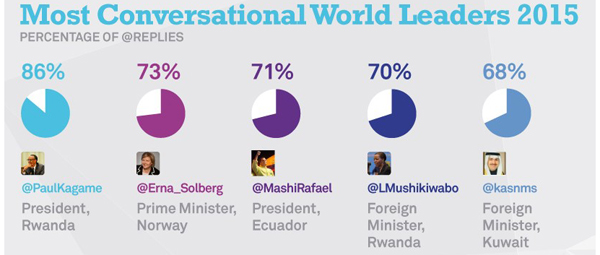Burson-Marsteller’s Twiplomacy study says Rawanda, Kuwait leaders chattier than Modi on Twitter
PR News
Paarul Chand
Prime Minister Narendra Modi is among the top three most followed leaders in the world after President Barak Obama and Pope Francis. According to Burson-Marsteller’s latest Twiplomacy study, released today, the five most followed world leaders were U.S. President Barack Obama (@BarackObama) (57 million followers of the U.S. president’s campaign account), Pope Francis (@Pontifex) with 20 million followers on his nine different language accounts, India’s Prime Minister @NarendraModi, Turkey’s President Recep Tayyip Erdoğan (@RT_Erdogan) and the @WhiteHouse.
However, the most followed world leaders follow few other peers, and they are hardly conversational. @BarackObama and the @WhiteHouse only follow four other world leaders, namely Norway’s Erna Solberg, Russia’s Dmitry Medvedev, the UK government and Estonia’s Foreign Minister Keit Pentus.Rwanda's President @PaulKagame is the most conversational world leader with 86% of his tweets being @replies to other Twitter users. Other highly conversational leaders are from Norway and Kuwait. India’s Prime Minister-although among the most followed and most retweeted – is not among the most interactive.

Twitter has also become the social media channel of choice for world leaders to reach large audiences with key messages and sound bytes.Governments are putting more effort into their social media communication and are including more visuals and videos in their tweets. Some, such as the @Elysee Palace, are regularly posting six-second Vine videos to summarize state visits or to cheer their national team, as the German Foreign Ministry did during the World Cup. A handful of leaders, including the Elysée Palace and the Kremlin, are also early adopters of Twitter's new livestreaming application, Periscope. Colombia's President Juan Manuel Santos has recently gone live on Periscope to announce the resumption of air raids against the FARC rebels.
“This study illustrates that governments are becoming savvier and more professional in the use of social media,” said Jeremy Galbraith, CEO of Burson-Marsteller Europe, Middle East and Africa and Global Chief Strategy Officer. “It is interesting to see how foreign ministries have honed their social strategies and built substantial dedicated teams to manage their online channels. We believe corporations can learn a lot from governments and their leaders on Twitter.
The study analyzed 669 government accounts in 166 countries and revealed that 86 percent of all 193 United Nations (UN) governments have a presence on Twitter. One hundred and seventy-two heads of state and government have personal Twitter accounts and only 27 countries, mainly in Africa and Asia-Pacific, do not have any Twitter presence.
More than 4,100 embassies and ambassadors are now active on Twitter. In New York, Washington, London and Brussels, most diplomatic missions use Twitter to have a voice at the digital table. Canada, the EU, France, Israel, Mexico, the Netherlands, Poland, Russia, Spain, Sweden, Turkey, Ukraine, the UK and the U.S. have put most of their embassies and missions on Twitter. The UK Foreign Office in London also encourages personal engagement by its ambassadors, and it is virtually impossible to become a Foreign Office diplomat without using digital tools.
If you enjoyed this article, you can subscribe for free to our weekly event and subscriber alerts.
Featured

PR professionals share their views on journalists publicly calling them out on story pitches

Auto blogger renders unconditional apology to Value 360 for defamatory posts

Hottest Indian startups of 2020, Paytm, Dreams 11 lead the charge: Wizikey Report




